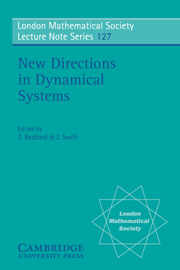Book contents
- Frontmatter
- Contents
- Preface
- Introduction
- Universality and Renormalisation in Dynamical Systems
- Smooth Dynamics on the Interval (with an emphasis on quadratic-like maps)
- Global Bifurcations in Flows
- Knots and Orbit Genealogies in Nonlinear Oscillators
- Limit Cycles of Polynomial Systems – Some Recent Developments
- Bifurcations with Symmetry
Bifurcations with Symmetry
Published online by Cambridge University Press: 23 December 2009
- Frontmatter
- Contents
- Preface
- Introduction
- Universality and Renormalisation in Dynamical Systems
- Smooth Dynamics on the Interval (with an emphasis on quadratic-like maps)
- Global Bifurcations in Flows
- Knots and Orbit Genealogies in Nonlinear Oscillators
- Limit Cycles of Polynomial Systems – Some Recent Developments
- Bifurcations with Symmetry
Summary
INTRODUCTION
Symmetries abound In nature, in technology, and - especially - in the simplified mathematical models that we study so assiduously. Symmetries complicate things and simplify them. They complicate them by introducing exceptional types of behaviour. Increasing the number of variables Involved, and making vanish things that usually do not vanish. They simplify them by introducing exceptional types of behaviour, increasing the number of variables involved, and making vanish things that usually do not vanish. They violate all the hypotheses of our favourite theorems, yet lead to natural generalizations of those theorems. It is now standard to study the ‘generic’ behaviour of dynamical systems. Symmetry is not generic. The answer is to work within the world of symmetric systems and to examine a suitably restricted Idea of genericity.
The pioneering work of Sattinger [1979, 1983], Vanderbauwhede [1982] and others opened up the possibility of a systematic theory, and during the past decade understanding of the bifurcation of dynamical systems with symmetry has developed into a recognizable subject with Its own distinctive identity: Equivariant Bifurcation Theory. It is not Just a tactical development: it embodies a general strategy for tackling the bifurcations of symmetric nonlinear systems. The technical machinery is extensive - Lie theory, representation theory, invariant theory, dynamical systems, and topology, for example - and the literature has grown to the point where the details can obscure the broader principles of the subject.
Symmetries are often exploited without being made explicit. For example, symmetry often forces multiple eigenvalues; but In any computation of those eigenvalues their multiplicity will emerge in due course.
- Type
- Chapter
- Information
- New Directions in Dynamical Systems , pp. 235 - 283Publisher: Cambridge University PressPrint publication year: 1988
- 4
- Cited by



